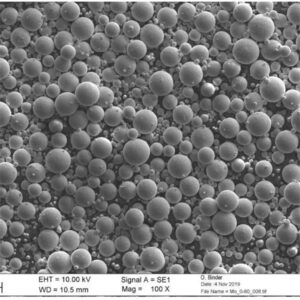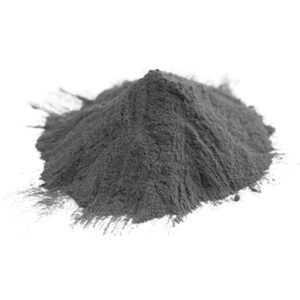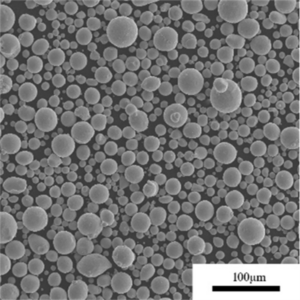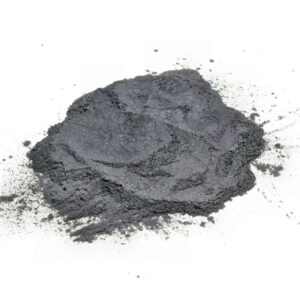Aluminium adalah bubuk logam yang populer untuk manufaktur aditif berkat kepadatannya yang rendah, sifat mekanik yang baik, kemampuan mesin, ketahanan terhadap korosi, dan konduktivitas. Mengoptimalkan karakteristik bubuk aluminium memungkinkan pencetakan komponen aluminium yang kuat dan ringan yang andal di seluruh aplikasi kedirgantaraan, otomotif, dan industri.
Panduan ini mencakup properti, spesifikasi, produksi atomisasi, pertimbangan jaminan kualitas, aplikasi, dan saran mengenai sumber serbuk aluminium untuk powder bed fusion atau pencetakan 3D jet pengikat.
Bubuk aluminium printer 3d Komposisi
Nilai aluminium yang umum untuk AM meliputi:
| Paduan | Deskripsi | Komposisi khas |
|---|---|---|
| AlSi10Mg | Paduan cor dengan tambahan silikon dan magnesium untuk kekuatan dan ketahanan terhadap korosi | Sisa Al, 9-11% Si, 0,25-0,45% Mg, 0,8% max Fe, 0,2% max Cu |
| AlSi7Mg | Sangat mirip dengan AlSi10Mg dengan kandungan silikon yang sedikit lebih rendah | Sisa Al, 6-8% Si, 0,25-0,45% Mg, 0,8% maks Fe, 0,2% maks Cu |
| 6061 | Paduan tempa yang dapat diolah dengan panas yang sangat umum dengan magnesium dan silikon | Sisa Al, 0,8-1,2% Mg, 0,4-0,8% Si, 0,7% max Fe, 0,15-0,4% Cu, 0,04-0,35% Cr |
Sesuaikan komposisi dengan sifat mekanis, ketahanan korosi, kebutuhan kemampuan las dan biaya paduan.

Ikhtisar Spesifikasi
| Parameter | Detail | Metode pengujian |
|---|---|---|
| Kemurnian | Lebih disukai Aluminium >98% | Analisis ICP |
| Bentuk partikel | Bulat> 90% yang diinginkan | Mikroskopi |
| Distribusi ukuran | D50: tipikal 25-45 μm | Difraksi laser |
| Kepadatan yang tampak | 1,2-1,8 g/cc | Pengukur aliran aula |
| Kemampuan mengalir | Aliran aula 25-50 detik untuk 50 g sampel | Pengukur aliran aula |
| Oksida & Hidroksida | <3% menurut beratnya | TGA, XRD, Fusi gas inert |
| Kadar air | <0,2% menurut beratnya | Analisis TGA |
Kualitas dan konsistensi serbuk yang tinggi diperlukan untuk meminimalkan cacat pada pemrosesan AM menjadi komponen dengan kepadatan tinggi dan kuat.
Metode Atomisasi
Produksi bubuk aluminium printer 3d melalui:
- Atomisasi Udara - Udara bertekanan tinggi menghancurkan aluminium cair menjadi tetesan bola halus yang mencegah oksidasi. Proses dengan energi yang lebih rendah menghasilkan partikel yang lebih besar yang cocok untuk pencetakan jet pengikat.
- Atomisasi Nitrogen - Nitrogen ambien mencegah oksidasi permukaan selama atomisasi sehingga memungkinkan ukuran serbuk yang lebih halus, oksigen yang lebih rendah, dan karakteristik aliran yang lebih tinggi yang lebih disukai untuk SLM dan EBM.
- Atomisasi Berputar Elektroda - Pemintalan aluminium cair tipis dengan cepat ke dalam nitrogen menghasilkan bubuk dengan distribusi ukuran yang sangat ketat dengan kepadatan kemasan yang baik.
Mengontrol atmosfer proses, laju pendinginan, dan dinamika gas mengoptimalkan ukuran dan morfologi partikel aluminium untuk aplikasi powder bed yang membutuhkan respons aliran dan geser yang baik.
Sifat Mekanis
| Paduan | Kepadatan (g/cc) | Kekuatan Luluh (MPa) | Kekuatan Tarik (MPa) | Perpanjangan |
|---|---|---|---|---|
| AlSi10Mg | 2.68 | 228 | 398 | 7.9% |
| AlSi7Mg | 2.74 | 261 | 372 | 8.1% |
| 6061 | 2.70 | 241 | 303 | 11% |
Memenuhi kekuatan yang ditentukan memerlukan parameter pencetakan yang dioptimalkan dan pasca-pemrosesan seperti penuaan. Orientasi komponen juga secara signifikan memengaruhi performa mekanis.
Aplikasi AM Logam
Aluminium AlSi10Mg digunakan secara luas di seluruh industri untuk diproduksi secara aditif:
- Kedirgantaraan & Pertahanan: Badan pesawat yang ringan, komponen UAV; penukar panas konformal dan pelat dingin; struktur kisi aktif. Perkakas cepat untuk peletakan komposit.
- Otomotif: Aluminium memiliki energi yang terkandung 3X lebih rendah daripada baja sehingga memungkinkan efisiensi bahan bakar yang lebih besar melalui pengurangan berat. Panel bodi mobil yang disesuaikan, perlengkapan, elemen sasis seperti lengan kendali memungkinkan peningkatan kinerja. Komponen penukar panas seperti rumah berjenis menambah keuntungan fungsionalitas. Jig dan perlengkapan untuk komposit serat karbon.
- Industri: Produksi seri yang disesuaikan untuk ukuran lot kecil hingga menengah. Pendingin untuk manajemen termal elektronik dengan faktor bentuk yang dioptimalkan. Komponen aliran fluida seperti impeler, pompa, katup, dan rumah. Jig, perlengkapan, pemandu, dan pengukur yang menawarkan daya tahan yang ringan.
- Arsitektur: Suku cadang khusus yang dibuat sesuai permintaan. Elemen dekoratif menggunakan pencetakan hibrida dengan pengisi perunggu. Model skala yang akurat secara dimensi untuk visualisasi.
Standar Sertifikasi
- ASTM B556 - Spesifikasi Standar untuk Komponen Struktural Paduan Aluminium Metalurgi Serbuk (PM) yang Menggunakan Paduan 6061
- ASTM B925 - Spesifikasi Standar untuk Serbuk Paduan Aluminium Kualitas Premium untuk Pemrosesan melalui Metode Metalurgi Serbuk untuk Aplikasi Otomotif, Dirgantara, dan Pertahanan
- ASTM E2926 - Spesifikasi Standar untuk Bubuk dan Bahan Baku Aluminium Manufaktur Aditif
Tinjau sertifikat batch yang divalidasi secara statistik yang menunjukkan kesesuaian terhadap spesifikasi tingkat target dan kebutuhan pemrosesan AM sebelum membeli.
Cacat Umum
Cacat AM logam aluminium utama dengan akar penyebabnya:
| Cacat | Karena | Solusi |
|---|---|---|
| Porositas | Kelembaban; Oksida; Penguapan logam | Turunkan kelembapan; minimalkan oksida; sesuaikan kepadatan energi |
| Retak | Pendinginan cepat; Tegangan sisa; Kotoran | Optimalkan pemanasan awal pelat bangunan; Pengepresan isostatik panas; Bubuk dengan kemurnian tinggi |
| Delaminasi | Kekuatan bilah recoater; Fusi lapisan yang buruk | Distribusi ukuran bubuk yang halus; Optimalkan lapisan olesan; Validasi pengaturan penyebar |
| Balling | Tegangan permukaan yang tinggi menghambat aliran | Panaskan pelat agar lebih cepat meleleh |
| Masalah Permukaan Akhir | Percikan, partikel yang tidak meleleh menyatu | Optimalisasi parameter untuk bubuk tertentu |
Menyesuaikan parameter pencetakan melalui uji coba untuk menghasilkan komponen yang sepenuhnya padat sebelum produksi seri.
Faktor Harga
| Parameter | Dampak |
|---|---|
| Kelas bubuk | Kemurnian / kebulatan yang lebih tinggi memiliki harga yang mahal |
| Ukuran lot | Penghematan skala ekonomis pada 500+ kg |
| Tingkat sertifikasi | Sertifikasi penuh vs pengujian batch |
| Metode atomisasi | Nitrogen > Udara karena konsistensi yang lebih tinggi dan oksida yang lebih rendah |
| Logistik regional | Sumber secara lokal jika memungkinkan |
Harapkan harga sekitar $50-100/kg untuk distribusi bubuk AM aluminium ukuran lebih rendah yang dikirimkan. Produsen yang lebih besar menawarkan skala ekonomis.
Pertimbangan Pembelian
| Parameter | Pentingnya |
|---|---|
| Kepatuhan terhadap kualitas | Tinggi |
| Ketersediaan sampel | Tinggi |
| Keahlian teknis | Sedang |
| Referensi pelanggan | Sedang |
| Harga | Rendah |
Perbandingan Vendor
| Produsen | Kisaran Ukuran | Kualitas | Konsistensi | Waktu Pimpin | Harga |
|---|---|---|---|---|---|
| [Merek 1] | 10-45 μm | Tersertifikasi penuh | Sangat konsisten | 12-14 minggu | $$$ |
| [Merek 2] | 15-65 μm | Pengujian batch | Variasi kecil | 3-4 minggu | $ |
| [Merek 3] | 10-63 μm | MPI Independen | Memenuhi spesifikasi minimum | 8-10 minggu | $$ |
Pilih merek terkemuka yang selaras dengan kebutuhan pemenuhan kualitas aplikasi suku cadang meskipun dengan harga premium untuk menghindari risiko cacat dan penyimpangan properti.

Pertanyaan Umum
T: Berapa ukuran partikel yang optimal untuk fusi unggun serbuk laser aluminium?
A: Fraksi ukuran serbuk aluminium 25-45 μm memfasilitasi pengemasan yang padat dengan respons geser dan aliran leleh yang baik, ideal untuk penyebaran dan fusi densitas tinggi pada aplikasi powder bed.
T: Bagaimana cara menyimpan bubuk aluminium AM dengan benar?
J: Segel wadah kedap udara dengan kantong penyerap kelembapan untuk mencegah oksidasi dan stabilisasi yang membatasi masa simpan hingga 6-12 bulan jika disimpan dengan benar di tempat yang sejuk dan terhindar dari sinar matahari langsung.
T: Apakah bubuk aluminium untuk logam AM memerlukan tindakan pencegahan penanganan khusus?
J: Diklasifikasikan sebagai tidak berbahaya tetapi gunakan serbuk di area yang berventilasi baik dengan APD yang disetujui karena partikulat logam halus dapat membahayakan kesehatan pernapasan dan risiko ledakan debu yang memerlukan protokol keselamatan.
T: Pemrosesan pasca apa yang biasanya dilakukan pada komponen aluminium yang diproduksi secara aditif?
J: Komponen Aluminium AM sering kali menjalani perawatan larutan, pengerasan presipitasi penuaan, pasivasi, dan pemolesan listrik untuk meringankan tegangan sisa, meningkatkan sifat mekanis, dan hasil akhir permukaan. Lapisan pelindung meningkatkan ketahanan terhadap korosi dan keausan.






